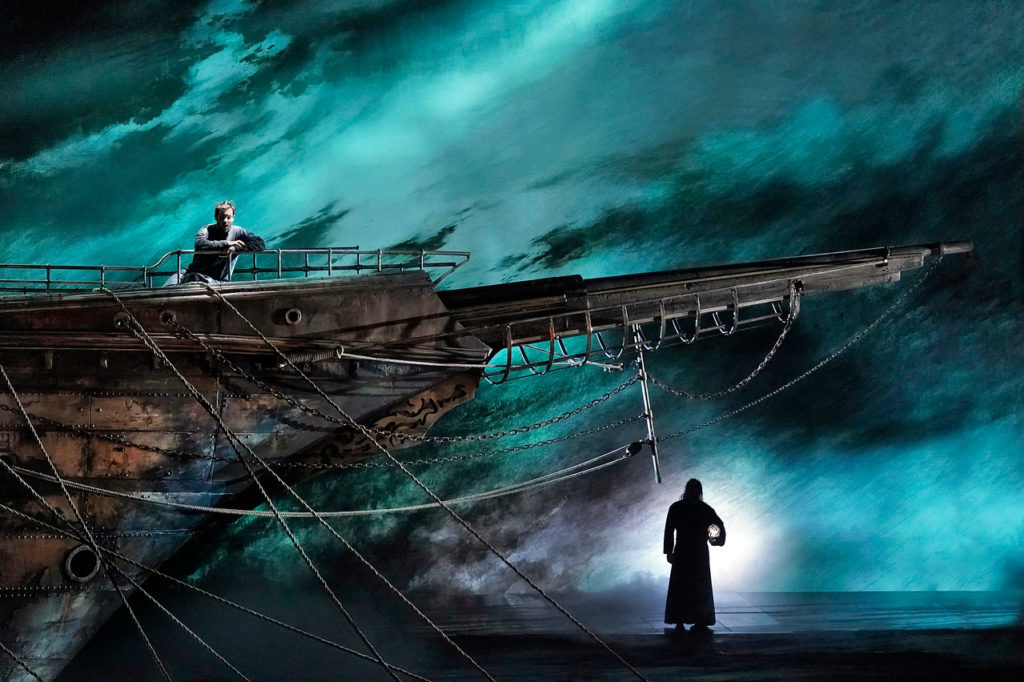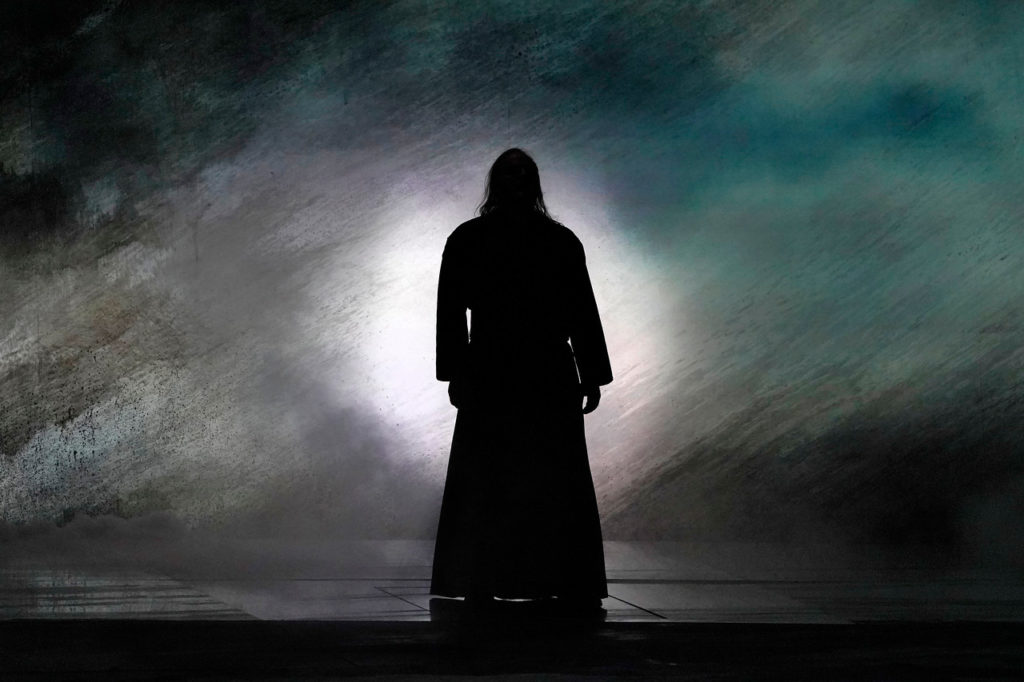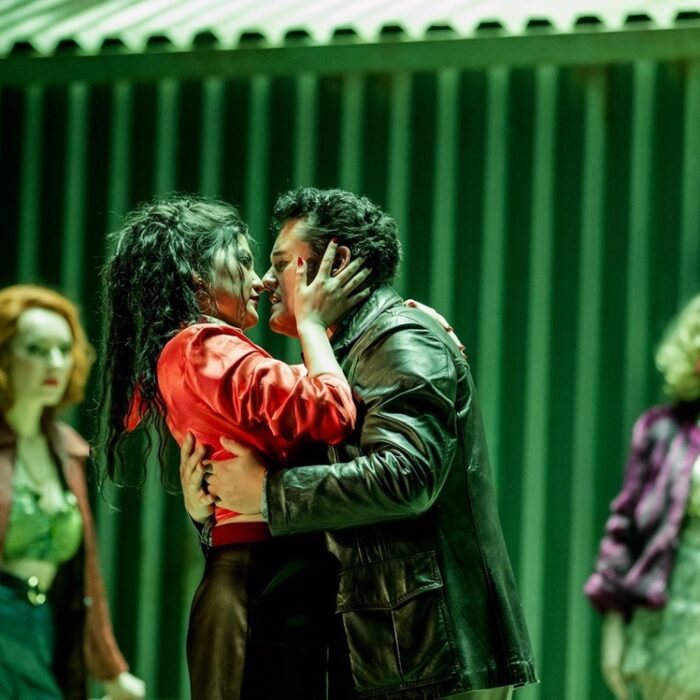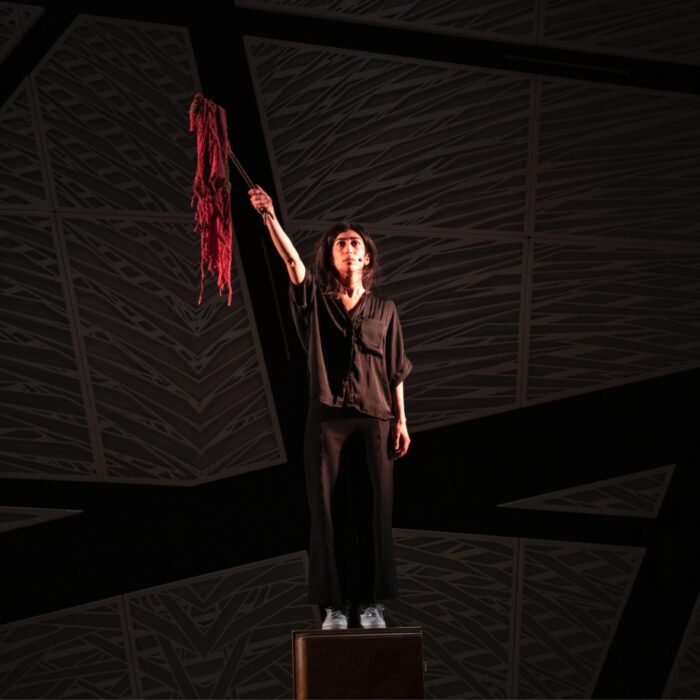
Metropolitan Opera 2019-20 Review: Der Fliegende Holländer
Anja Kampe’s Senta Truly Saves This Disappointing Dutchman Production
By David Salazar(Credit: Ken Howard / Metropolitan Opera)
For its final new production of the 2019-20 season, the Metropolitan Opera turned to Wagner’s “Der Fliegende Holländer” in a production by François Girard, whose previous work with the company is an iconic “Parsifal” production.
The beauty of that production is how it illuminates one of the most complex and philosophically dense operas ever written. Every moment in that production is full of visual splendor that wraps you up in its world and takes you on a truly transcendent journey.
It was a high mark for this new production to live up to. It initially seemed like it actually might, was ultimately unable to.
All About Senta, But Little Else
The curtain greeting the audiences featured a dark, withered eye, which will later be revealed as the painting that Senta is so fixated on when the curtain rises. A transparent curtain downstage enables projections to appear, exploring the tumultuous storm that is delineated by the music, all while dancer Alison Clancy, dressed in Senta’s red dress, moved about transfixed by the painting and the emotions hurling around her. It was the image of someone possessed by passion and love. This opening was nothing short of breathtaking and even some faulty orchestral playing could not take away from the enchantment it cast. It firmly rooted the story in Senta’s perspective, her red dress further separating her from the crowd, mostly clad in grey or white, throughout the evening.
Once the overture was done, a massive ship entered from stage right, dominating half of the space. It set the scene for Daland and his crew, with the other half of the stage, empty and haunting. Eventually, the Dutchman would rise on stage left as a silhouette to potent effect; the lighting design was wondrous throughout the night with this being the first of two shining moments. As the Dutchman walked downstage, a massive shadow dominated the wall upstage, a motif that would follow him throughout; he was haunted by his own shadow, the curse that has dominated his existence.
In the ensuing scene, ropes came down from above, designated for each woman in the chorus. The choreography in this scene emphasized how the women, pulling on similar ropes to the ones that the men were pulling on, were all parts of a machine; later on, their devotion to the ropes would be replaced by fixation on shining objects given to the men by the Dutchman. These enchantments suggested that the Dutchman’s curse extended to everyone else; he untangles the ropes at the end of his scene with Senta, suggesting his transcendent power.
The ubiquity of his curse could also be at the core of Senta’s obsession with him. Senta, who again, is at the core of the production doesn’t seem to care for anyone else but the Dutchman. When her father arrives, she doesn’t even look at him, giving him a subtle kiss. Her relationship with Erik is non-existent in their two scenes together and for much of the opening chorus with the other women, her back is to them. Only when Senta is with the Dutchman is there a suggestion of interest.
At the ending of the opera, the chorus throws Senta into the ocean and merges into the projections of the water as her red dress becomes one with the grey backdrop, also suggesting a transcendent beauty that does not fit with this reading of the Dutchman’s curse extending beyond himself. This effect was the second striking moment of lighting virtuosity.
Despite these choices however, it was impossible not to feel let down by the production as a whole. The characterizations of the other major players felt one-dimensional at best and non-existent at worst. The blocking was static for lengthy portions. During duets or trios, characters would stand on opposite sides of the stage and sing, barely ever interacting with one another. The chorus got some movements, but they were placed on repeat for the full length of the musical passages without substantial development or evolution. Finally, the overall color palette, mostly dominated by black, felt fairly similar to the previous production it was replacing. Ultimately, Girard didn’t really bring much new to the table thematically aside from some stunning visual effects and Senta’s centrality.
Of course, Met audience members that want something traditional will definitely find this a step up from the previous staging of the opera. But not by much.

(Credit: Ken Howard / Met Opera)
Not Quite At Home
The musical aspects of the performance were mixed. In the title role, Evgeny Nikitin had a tall task to fill as he was brought in just a little over a month ago when Bryn Terfel was forced to step out after suffering an injury.
Nikitin was a fantastic Klingsor in “Parsifal,” but the reasons why he was so perfect for that role are the very reasons why he often felt miscast in this one. His voice has a very hard-edged quality that allows him to portray vocal menace and aggression quite well. But his coarser timbre doesn’t have a vast color palette that he can navigate to provide greater expressive range. While you could definitely feel the bitterness and anger of “Die Frist ist um” and “Wie oft im Meeres tiefsten Schlund” during his opening recitatives and phrases of his aria, he couldn’t muster a sweeter or gentle quality for the pianissimo phrases on “Dich frage ich, gepries’ner Engel Gottes.” The sound, while not as forceful in approach, retained the harsher timbre. Ultimately, in this aria, Nikitin exposed the limited vocal colors and dynamic range he had at his disposal, leaving few musical surprises for the remainder of the performance.
High notes tended to have a muddled, nasal quality and his singing often got overpowered by major orchestral outbursts or his co-stars (the climax of the love duet is one major example where soprano Anja Kampe covered him completely). As the night wore on, his voice became more brittle and in his final moments, as he declares the curse that would befall anyone who follows him, he seemed to be running out of vocal resources, though he was definitely giving it all he had to put a final stamp on the performance.
Ultimately, it was a performance rather lacking in nuance or depth, which was only emphasized by a rather stiff and stern body language throughout. Obviously, the Dutchman is a tortured soul, but not even the idea of Senta or having her profess her love to him brought any humanity to his reactions. This is likely less on Nikitin and more on Girard’s choice to diminish the Dutchman’s role in the drama, but the Russian bass-baritone’s characterization had as much profundity as the shadow projected behind him, making it hard to truly be immersed in his tragedy.
If there is one thing that Nikitin did well throughout the night was deliver some really solid and consistent legato singing. Whether it be his aria, the duet with Daland, or especially the duet with Senta, he displayed a commitment to connected and flowing line. “Wohl hub auch ich voll Sehnsucht meine Blikke” was one such example of how solidly he connected note to note and all of his registers, allowing for the character’s noble qualities to shine through.

(Credit: Ken Howard / Metropolitan Opera)
Shining Star
As noted, Senta is at the core of this story, often placed in the center of the stage. And Anja Kampe, in her hotly anticipated Met debut, made a riveting star turn. Her voice is textured and rich, with a firm middle and low and potent highs.
She commenced her famed ballad with soft low notes, crescendoing slowly to the final D natural fermata before fading away. Then her ensuing attack on the G natural “Traft ihr das Schiff” provided swift contrast, the phrases more angular and consonants more accented as she looked around her. It all built with energy until suddenly, she stopped, grabbed the rope at the center of the stage and started to sing “Doch kann dem bleichen Manne” with tender and hushed tones. While she struggled with the shifts from the middle voice into the passaggio on the piano F natural and G on “Werden” and “Erden,” the pitches a bit unstable, her singing throughout his passage was tinged with nostalgic longing.
The second section of the narration built on the first with Kampe’s voice firmer and more resolute, allowing for her reprisal of “Doch dass der arme Mann” to be even gentler in approach. Here she found firmer footing with those vocal transitions into her passaggio. The final portion of the narration started off with greater accentuation before slowing down and diminuendoing into the chorus’ passage. Here Kampe moved away from the rope and toward the lower part of the stage before throwing herself fully into the climactic “Ich sei’s, die dich durch ihre Treuerlöse!” She poured out all her vocal resources here, really driving her sound toward the high A flats to visceral effect.
She was stunning during the duet with the Holländer. Starting with a very hushed piano dynamic on “Vesank ich jetzt,” she slowly crescendoed with each passing phrase, moving from a delicate quality on the glorious “Er steht vor mir” to pure exhilaration on the climactic high notes. Her voice blossomed and those climactic passages really thundered into the hall with the whole note high B natural the most exciting note sung the entire evening; her transition into the scalar descend might not have been the cleanest in execution, but she was riding the vocal edge with such confidence and intensity that it was impossible not be swept away by it.
She seemed to throw caution to the winds on the big high notes, really letting her soprano pour into the theater with abandon. This was most present throughout the trio, which she dominated and at the close of the night she blasted out a masterful high A natural on “Ich bins” and a fantastic high B natural on “Treu” right before running to her doom.
Kampe’s Met debut has been long awaited and she did not disappoint in the least.

(Credit: Ken Howard / Metropolitan Opera)
Other Impressive Turns
Another impressive performance came from tenor Sergey Skorokhodov. The Russian singer possesses a very firm and stable tenor with flexibility across his range. He did seem a bit overpowered in his opening exchange with Senta, but slowly grew into the scene and was especially wonderful during his Kavatine.
While there were some strange intonation issues at the start of the Kavatine, his line was fluid, the sound consistently bright and potent and his ascensions to the several higher notes were dispatched with confidence. He really took emotional flight during “Als sich dein Arm,” climaxing the phrase on a powerfully sustained high B flat and building momentum throughout the rest of the phrase despite seemingly left at sea by the orchestra in several patchy moments. He ended the passage with a ringing High A and A flat before diminuendoing to the final F natural on “Treu’.”
As Daland, Franz-Josef Selig struck a congenial, though subdued, figure, his bass consistently resonant and pleasant. In his duet with the Holländer and the trio with his daughter and the titular character, his musical figures tended toward the rhythmic and Selig showcased a very delicate but articulate vocal presence.
Meanwhile, tenor David Portillo provided a bright tenor to his opening passage, a nice contrast to the darker vocal colors around him.
Mihoko Fujimura, in her Met debut as Mary, made the most of her few appearances in the second act, her voice solid.
Lacking Life
The Met Opera Chorus did some good work at the start of the opera, though there were moments where cohesion was not optimal. There were cutoffs in the first Act where some singers noticeably ended after other ensemble members. And during the choral passage that contrasts the sailors with the spirits and the women, there was clearly some sloppiness all around.
Of course, a lot of this falls at the hands of the man in the pit – Valery Gergiev. The Russian maestro’s approach lacked in nuance and tended toward extremes of understated to overblown. The overture’s opening heavily favored the brass sound to the detriment of the strings. But moreover, he didn’t emphasize a more accented quality to the brass, so their phrasing in many instances during this stormy and harsh musical passage came off as overly smooth and tame. This was a common theme in heavier sections of the overture and throughout the opera, undercutting the score’s contrasts throughout.
He did better with the softer passages, opting for slower tempi and stretching them out for all he could muster. Many times, it worked marvelously, particularly with Kampe or even in Nikitin’s opening aria, but during sections of Skorokhodov’s Kavatine, it felt like Gergiev was not on the same page as the tenor.
But more than his challenges with balancing orchestral colors or following his singers was the overall feel that the orchestra was just along for the ride without being a major character in the drama. This is undoubtedly a challenging score, but it often felt lifeless and perfunctory; a necessity rather than a major piece of the puzzle.
It summed up what could be seen as a disappointing evening on many levels. But Anja Kampe’s big night was also symbolic of the opera of large – like Senta she lifted it up and filled it with powerful life. She isn’t scheduled to return to the Met in 2020-21, so you don’t want to miss her remaining seven performances.


